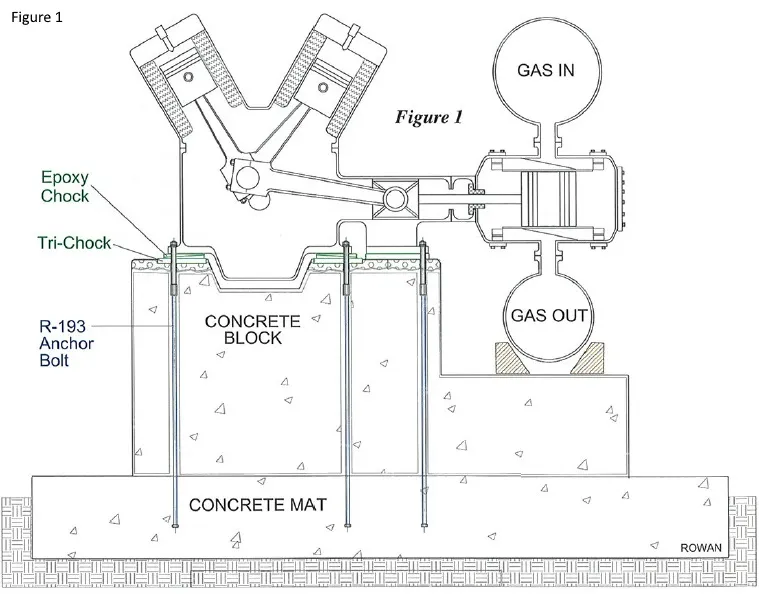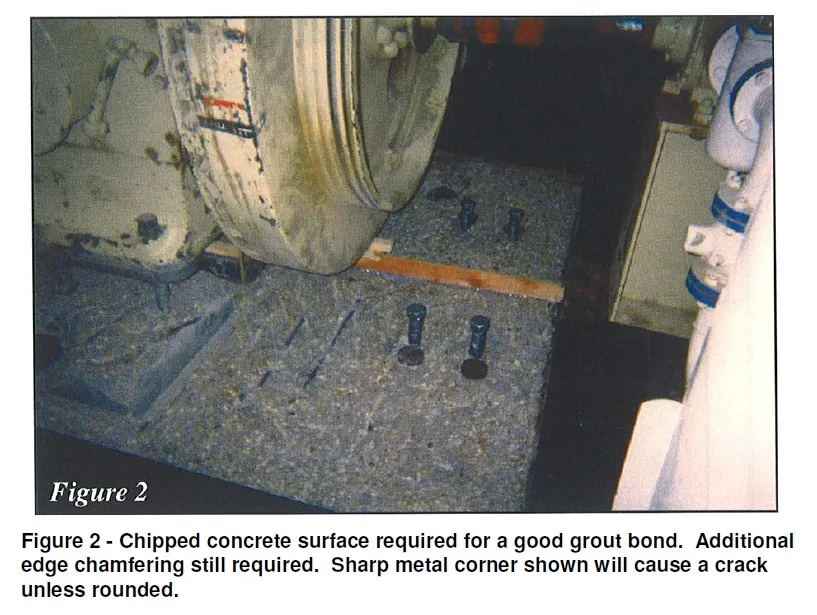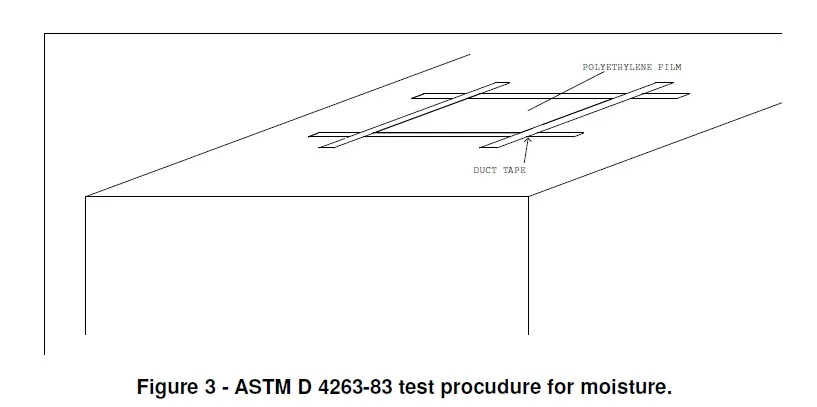Foundations - Curing, Inspection and Preparation
Equally as important as the types of machinery grouts (organic and inorganic) available, which were discussed in earlier issues of the Grouting Technology Newsletter, is the concrete foundation itself.
Every machinery installation consists of three major parts (See Figure 1):
- the concrete foundation
- the machinery
- the attachment system of anchor bolts and grout (or often, in addition, a support subassembly of adjustable sole plates and epoxy chocks).
This issue will deal primarily with the concrete foundation, how to prepare it for grouting, and why a good foundation is extremely important in achieving A smooth-running machinery installation.
In the typical installation of a block-mounted, gas engine compressor, such as is found in gas transmission compressor stations, refining and chemical process plants, or in gas processing plants, the concrete foundation performs two basic functions. First, it provides a means of distributing the combined weight of the concrete block and machinery into the concrete mat and the soil below.

Secondly, through its mass, oftentimes three to eight times that of the machinery, it absorbs those dynamic forces which are a by-product of the work being performed by the machine.
The more evenly balanced and smooth-running the machine, the less unbalanced forces there are which must be transmitted from the machine, through the grout and into the foundation. An understanding of this function points out the importance of a good grout and anchor bolt system to join the machine to the concrete block. Excessive vibration is often a symptom of a problem in one of the links in the attachment system. It also can be from an abnormal machinery operating condition, where the unbalanced forces have increased beyond normal operating forces.
Because the block is so important, it should be inspected before grouting to be sure it is structurally sound, of good quality concrete, and properly cured.
Just because concrete is new doesn't automatically make it good. Cracks can develop in a new concrete block from foundation settling, an improperly sized mat, soil problems, or from mixing and placing problems. Certain local aggregates can contribute to cracking problems, as well. While the compressive strength required is a part of the mix specification, when an epoxy grout is to be used, the tensile strength also becomes important. Fortunately, concrete gets stronger in both compressive and tensile strength with age, so length of cure time must be considered. As a rule of thumb, at least 28 days of cure at 68° F. are needed to meet the strength and moisture content requirements before grouting. If inspection of a newly poured block shows major cracks have developed, an investigation should be made to determine if they are the result of perhaps a one-time stress from the curing/hydration process or if the cracks are a result of some fault in the system: perhaps a cracked mat or a subsoil/piling condition.
If such cracks are due to a fault in the system, they usually need to be repaired structurally, since it is impossible to guarantee precision alignment of the machinery being supported if the block is cracked and does not behave as a monolithic block. Just cracks alone, those that are not working or moving cracks or do not have the potential to move, are not reason enough to condemn the block. Fortunately, concrete is a material of construction that can be repaired to a condition as good as new once the cause of the cracking problem is identified, corrected, and the proper repair procedures carried out. We specialize in providing this type of inspection and repair design.
Once the block passes muster, the load-bearing surface to be in contact with the grout, usually the entire top of the foundation, is ready for proper surface preparation. This has to be done before the machinery is lowered into place.
There is only one sure-fire preparation, and that is to use a chisel point to chip the top of the concrete to expose the aggregate. In the casting of a concrete block, the fines and impurities rise to the top and form a weak layer called laitance. This must be removed, and the surest way is to chip. A thickness of 1/2" to 3/4" must be removed to expose and break some of the large aggregate in the mix.
Acid etching, sandblast, and chipping with bush heads run a poor second in achieving the optimum surface for the grout to bond to. They should not be used!

Wet or Dry?
One of the techniques used to cure concrete is to keep the exposed surface wet to assist the cure. Water must be added to the surface to replace the water in the mix that evaporates daily, unless a curing agent is used to seal the water in. Weaker concrete results unless this is done. Whether the top is wet or dry after chipping becomes important depending on the type of grout to be used. Most cement based (inorganic) grouts require a damp surface prior to grout application. A bone-dry surface is best for most epoxy (organic) grouts. Therefore, if an epoxy grout is to be used, shelter from rain is a good precaution, and remember to remove any water from the anchor bolt sleeves.
How to Tell if Concrete Is Dry
If you are using an epoxy grout, you must know if the surface is dry enough to grout. A surface may look dry, yet have moisture just below, which will be drawn to the surface by capillary action if grout is poured on top. You may have seen the phenomenon of capillary action when you lifted a rubber door mat on a dry concrete sidewalk and noticed it was damp underneath.
Since moisture interferes with the bond of most epoxy grouts to concrete, knowing if there is moisture below the surface is important. There is now an accepted test for moisture in concrete - ASTM D4263 (See Figure 3). This test uses an 18" square of transparent polyethylene film taped to the top of the concrete. Water drawn to surface by capillary action will condense on the underside of the plastic sheet. Run the test 16 hours, per ASTM D4263, to be sure that water, which can be several inches below the top, does not reach what will be the grout concrete interface. Once the epoxy grout starts to cure (or "B" stage), water usually cannot interfere with the proper bond developing.
The test should be done in an area shaded from direct sunlight.

What to Do if Concrete Is Damp
While grouting standards should not be compromised under critical machinery, some manufacturers of epoxy grouts have developed damp concrete primers. Since "how damp is damp" is a subjective opinion, it is possible to encounter wet conditions that exceed the moisture-forgiving properties of these primers, and a weaker bond, or no bond might develop. Used prudently, damp concrete primers can allow a job to progress when downtime is critical.
Even though there are epoxy grouts that can even cure and bond under water, that class of material may not provide all the critical properties that are necessary for a precision equipment grout, and that type epoxy grout should not be substituted for an epoxy machinery grout.
Home > Newsletters > Foundations - Curing, Inspection and Preparation


